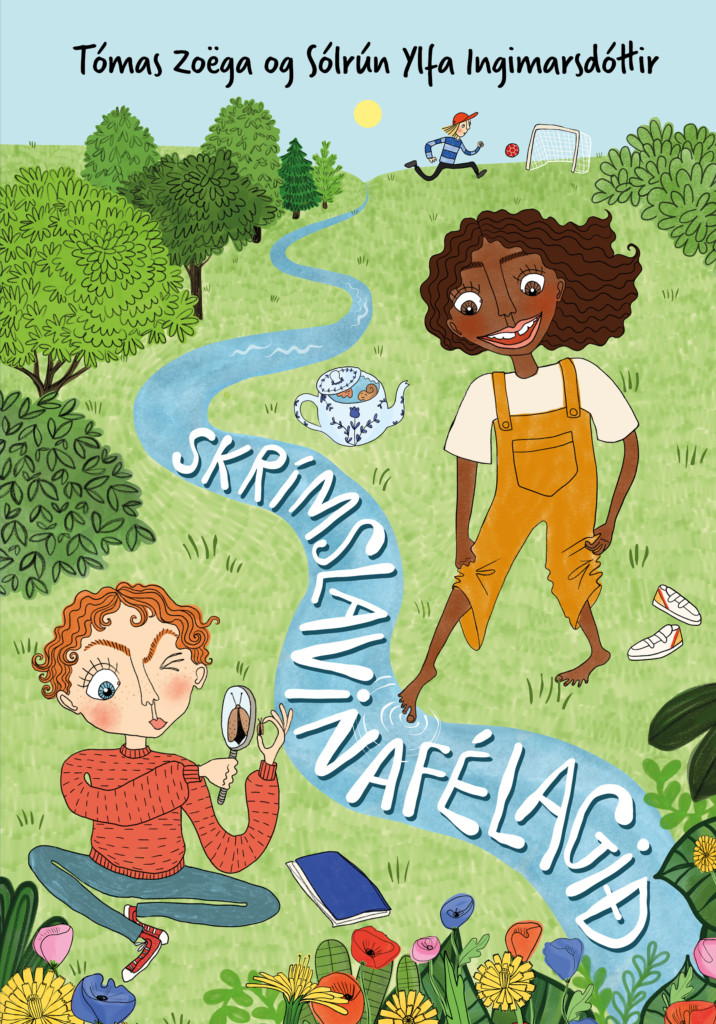Nominated for the Nordic Council Children and Young People’s Literature Prize 2024
Nominated for The Reykjavik Children‘s Literature Prize for the best illustrations 2024
Everyone knows that secrets are best kept in secret societies. That’s why Petur and Stefania establish The Secret Society of Monster Friends. It is debatable whether the snails that Stefania smuggles home and hides under her bed are actual monsters but when they find a mysterious (and potentially dangerous!) black powder in their school, things start getting dicey. That’s when the witch in the garage comes to their aid, renowned for her ability to solve unsolvable problems and, perhaps more importantly, keep secrets.
“The Secret Society of Monster Friends is about Stefanía and Pétur, who play together every day down by the dirty stream in the schoolyard and collect brave moss snails hiding among rusty shopping carts. We also meet Jóhann Steinn, who has just joined Stefanía’s class. It quickly becomes apparent that Pétur doesn’t like his new classmate at all and believes there’s no room for more than two in his and Stefanía’s secret club.
Skrímslavinafélagið is about everyday challenges seen from young readers’ perspectives in a simple and well-executed narrative, written with respect for the children. There is no focus on moralising; the strength of the book lies more in blending everyday life with an imaginative mindset. The authors have a unique way of highlighting all the insignificant and even fantastic things that characterise childhood.
Stefanía and Pétur extract a sample of some mysterious black powder produced by the wall of their school and show it to the local witch. Here, the child’s perspective becomes even clearer. The witch is an older woman in the neighbourhood who is slightly different from the traditional notion, without too much emphasis being placed on it. An adult reader realises what substance the children have found. Mold in school buildings is a common issue and even a societal problem in Iceland. But what adults view with great seriousness becomes a fantastic adventure for the children.
The characterisation in the book is particularly entertaining and shines best when the friends have to contend with external circumstances. Stefanía is curious, daring, and proactive, while Pétur is cautious and takes no unnecessary risks, neither with people nor with nature. Stefanía is a strong role model. She doesn’t tease, she’s energetic, and she’s fun, but she also guides her friend. Pétur, on the other hand, tends to become insecure. The dynamics between the characters help young readers develop a moral compass without it being directly imposed on them.
Sólrún Ylfa’s illustrations are colourful and vibrant, full of humour and little funny moments that make the book even more inviting. The style is targeted, and the illustrations complement the book’s text with their simplicity and numerous details.
The book is about friendship, about complications when two friends become three, about feeling left out, and about being allowed to join in. It invites conversations about decisions in children’s daily lives, their consequences for themselves and others, and about how to take responsibility for their actions. The theme has a direct connection to the reality of Icelandic children, but the problems conveyed never overshadow the adventure.”
THE NORDIC COUNCIL RATIONALE
“Monsters captivate children at a certain age, and the schoolmates and friends, Stefania and Petur, the protagonists of the book, are no exception. They embark on monster hunts in the muddy creek on the schoolyard where they encounter several perilous water blobs (which are a species of snail, if anyone was in doubt) and dangerous sticklebacks with horns. Following this, they establish the Secret Society of Monster Friends, and a vibrant sequence of events is set into motion, reminiscent of Astrid Lindgren’s Noisy Village.
The story’s consciousness is centered on Petur, who is the more cautious and anxious of the pair, a deeper investigator, and it is he who discovers the actual monster. This monster is invisible yet both genuinely dangerous and capable of dominating the lives of schoolchildren for years: the terrible mold! The story is interspersed with timeless elements, such as an enemy who becomes a friend after a disappearance from the narrative, and unique motifs like a witch who is also an inventor and possesses two bathtubs because she prefers not to bathe with her dog.
Addressing mold in this way in a children’s book is an excellent concept and executed well. Mold upends the lives of children nationwide, leading to school closures and the need to relocate teaching, disrupting both the children’s social lives and their sense of security, aside from the health hazards it presents. Thus, it is appropriate that the mold is depicted as the most dangerous monster, and although the children in the story are friends with most monsters, they are not friends with the mold. The book is humorous and enjoyable, easily readable for beginners with its large line spacing and comfortable font, vibrant and lively illustrations blending seamlessly with the text, making it even more readable.”
BRYNHILDUR BJORNSDOTTIR, HEIMILDIN WEEKLY
“…exciting, entertaining and funny.”
KATRIN LILJA, LESTRARKLEFINN

